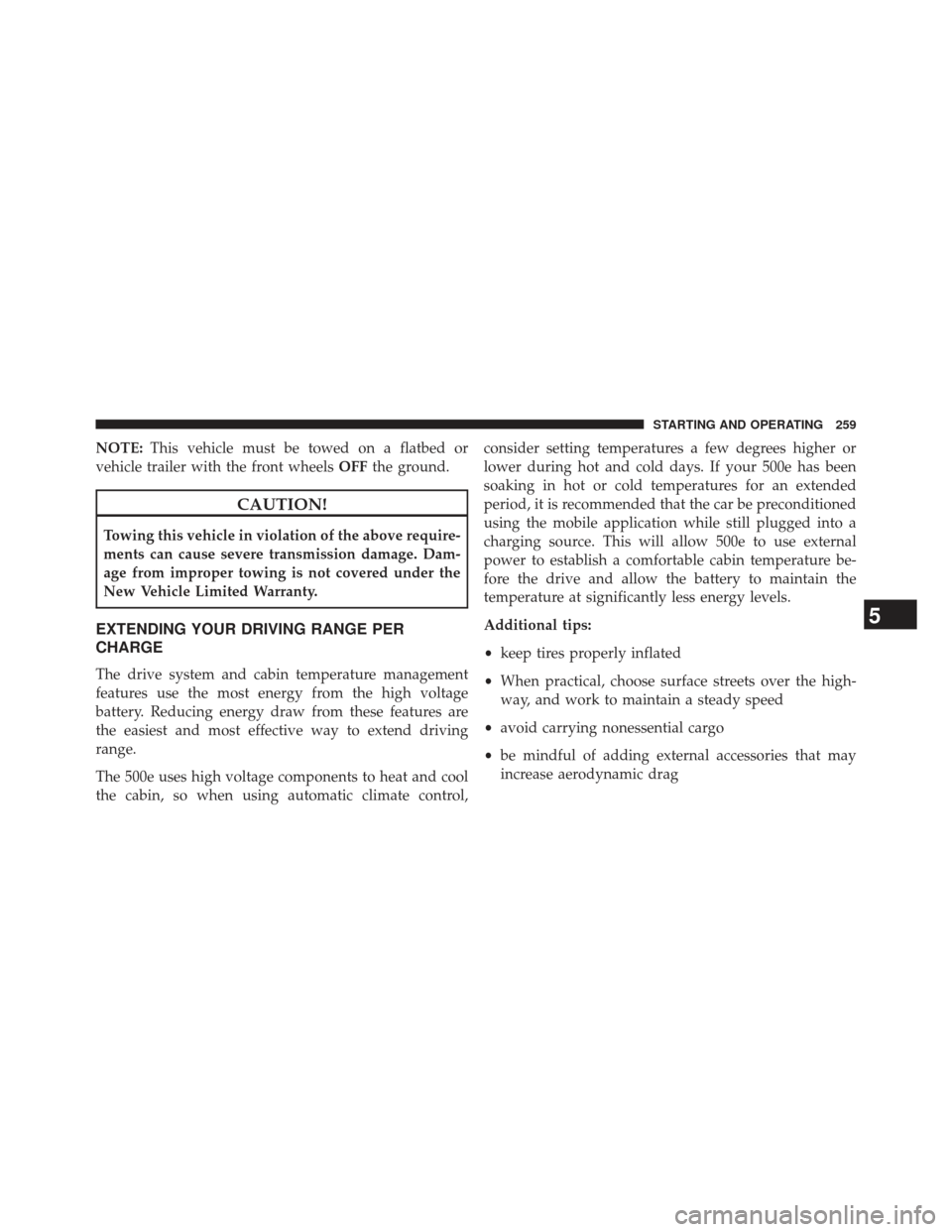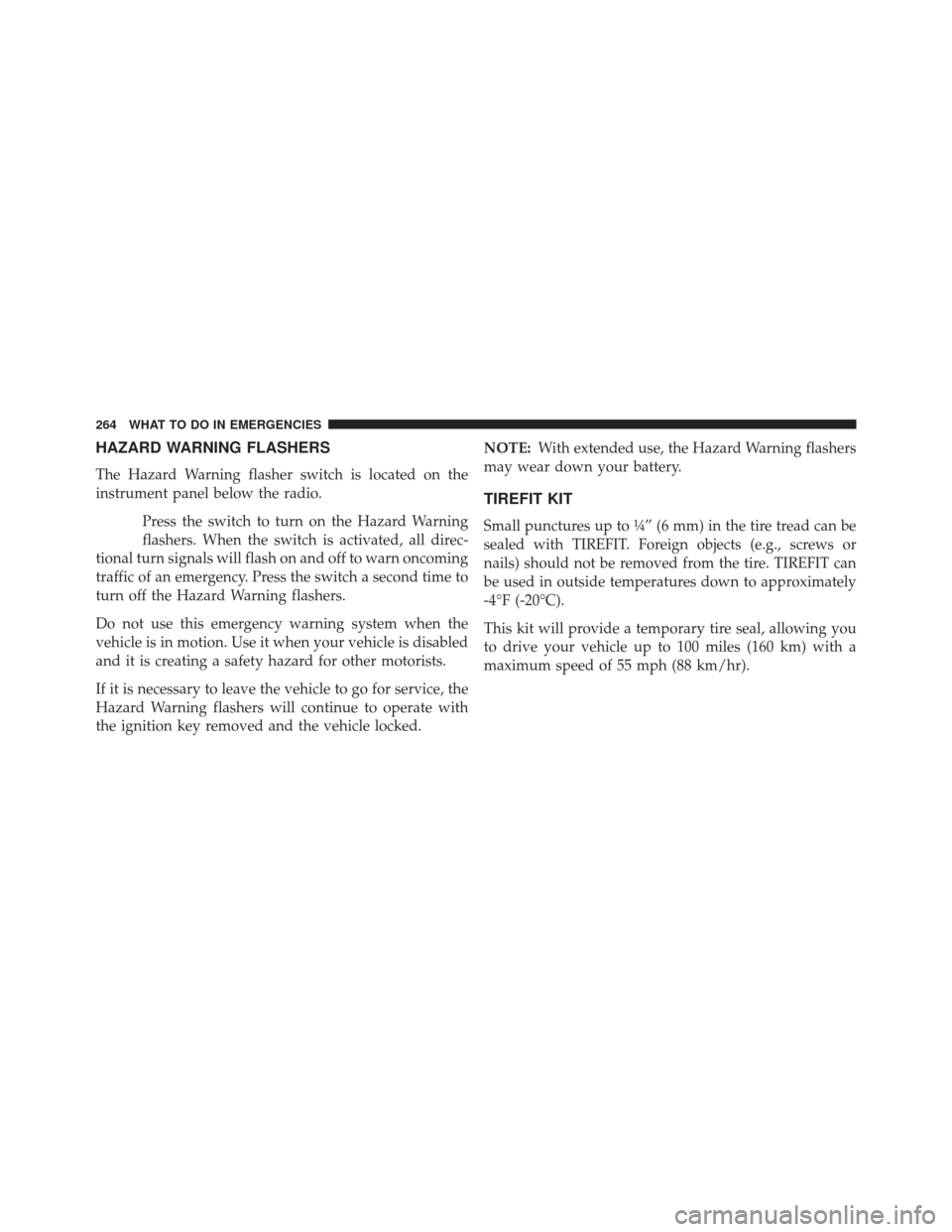Page 168 of 350
•avg. energy
• avg. speed
• elapsed time (driving time).
“Trip B” can be used to display the figures relating to:
• distance
• avg. energy
• avg. speed
• elapsed time (driving time).
Values Displayed
Range
This indicates the distance which may be travelled with
the remaining battery charge, assuming that driving
conditions will not change. The message “----” will
appear when the system is initializing. NOTE:
The range depends on several factors: driving
style, type of route (freeway, residential, mountain roads,
etc.), conditions of use of the car (load, tire pressure, etc.).
Trip planning must take into account the above notes.
Distance Traveled
This value shows the distance covered since the last reset.
Average Speed
This value shows the vehicle’s average speed as a func-
tion of the overall time elapsed since the last reset.
Elapsed Time
This value shows the time elapsed since the last reset.
166 UNDERSTANDING YOUR INSTRUMENT PANEL
Page 183 of 350

•High: function activated (high sensitivity)
On Volume Limit
This function makes it possible to activate/deactivate the
maximum volume limit when turning the radio on.
The display shows the function status:
•“On volume limit: on” – when the radio is turned on
the volume level will be:
– If the volume level is equal to or higher than the maximum value, the radio will come on at the
maximum volume.
– If the volume level is between the minimum and maximum values, the radio will come on at the
same volume as before it was switched off.
– If the volume level is equal to or lower than the minimum value, the radio will come on at the
minimum volume. •
“On volume limit: off” – The radio will come on at the
same volume as before it was switched off. The
volume level can be between 0 and 40.
Use the buttonsorto change the setting.
NOTE:
• Using the Menu it is only possible to adjust the
activation/deactivation of the function and not the
minimum or maximum volume value.
• If the battery charge is too low, the volume cannot be
adjusted between the minimum and the maximum
level.
Radio Off Function
This function makes it possible to set the radio switching
off mode by choosing between two methods.
4
UNDERSTANDING YOUR INSTRUMENT PANEL 181
Page 231 of 350

NOTE:
•The ESC Activation/Malfunction Indicator Light and
the ESC OFF Indicator Light come on momentarily
each time the ignition switch is turned ON.
• Each time the ignition is turned ON, the ESC system
will be ON even if it was turned off previously.
The ESC OFF Indicator Light indicates the
Electronic Stability Control (ESC) is off.
Regenerative Braking
Your 500e has a Regenerative Braking System (RBS). The
RBS increases the fuel economy of the vehicle, particu-
larly in stop-and-go city traffic. The electric motors which propel the vehicle forward can operate as generators
when braking. The RBS recharges the high voltage bat-
tery under certain braking conditions by recapturing
energy that would otherwise be lost while braking. The
electric power that is generated goes back into the high
voltage battery for later use, for example when accelera-
tion is desired.
The RBS uses conventional hydraulic friction brakes,
regenerative braking, or a combination to slow the ve-
hicle. If the system detects slippery conditions while
braking, mainly friction is used to slow the vehicle. The
RBS can result in extended life of the hydraulic service
brakes; however, all inspection, scheduled maintenance,
and service intervals for the vehicle service brakes must
be followed.
5
STARTING AND OPERATING 229
Page 261 of 350

NOTE:This vehicle must be towed on a flatbed or
vehicle trailer with the front wheels OFFthe ground.
CAUTION!
Towing this vehicle in violation of the above require-
ments can cause severe transmission damage. Dam-
age from improper towing is not covered under the
New Vehicle Limited Warranty.
EXTENDING YOUR DRIVING RANGE PER
CHARGE
The drive system and cabin temperature management
features use the most energy from the high voltage
battery. Reducing energy draw from these features are
the easiest and most effective way to extend driving
range.
The 500e uses high voltage components to heat and cool
the cabin, so when using automatic climate control, consider setting temperatures a few degrees higher or
lower during hot and cold days. If your 500e has been
soaking in hot or cold temperatures for an extended
period, it is recommended that the car be preconditioned
using the mobile application while still plugged into a
charging source. This will allow 500e to use external
power to establish a comfortable cabin temperature be-
fore the drive and allow the battery to maintain the
temperature at significantly less energy levels.
Additional tips:
•
keep tires properly inflated
• When practical, choose surface streets over the high-
way, and work to maintain a steady speed
• avoid carrying nonessential cargo
• be mindful of adding external accessories that may
increase aerodynamic drag
5
STARTING AND OPERATING 259
Page 262 of 350
•perform all scheduled maintenance at recommended
intervals
Driver Behavior Gauge
To help the driver extend the driving range of the high
voltage battery your vehicle is equipped with a Driver
Behavior Gauge. The Driver Behavior Gauge is located
on the right side of the instrument cluster and contains
three driving ranges:
• Power
The needle will move into the Power range when under
acceleration.
• ECO
The needle will move into the ECO range when you are
maximizing the driving range of the high voltage battery. •
Charge
The needle will move into the Charge range when battery
regeneration is active (either coasting or braking).
Driver Behavior Gauge
260 STARTING AND OPERATING
Page 263 of 350
Range Projection
This area of the cluster is used to display the projected
range of the high voltage battery. The two arrows to the
left of the mileage are used to forecast the effect of recent
driving.
•When both arrows are grey, expect the range to drop
approximately one mile for each mile driven.
• When the up arrow is highlighted, expect the range
number to hold steady or increase while driving.
• When the down arrow is highlighted, expect the range
number to decrease more than one mile for each mile
driven.
Range Projection Indicators
5
STARTING AND OPERATING 261
Page 265 of 350
WHAT TO DO IN EMERGENCIES
CONTENTS
�HAZARD WARNING FLASHERS ...........264
� TIREFIT KIT ......................... .264
▫ TIREFIT Storage ..................... .265
▫ TIREFIT Kit Components And Operation .....265
▫ TIREFIT Usage Precautions ...............266
▫ Sealing A Tire With TIREFIT ..............268
� JUMP-STARTING PROCEDURE (12 VOLT
BATTERY ONLY) ...................... .274▫
Preparations For Jump-Start ..............274
▫ Jump-Starting Procedure ................276
� FREEING A STUCK VEHICLE .............277
� MANUAL PARK RELEASE ................279
� TOWING A DISABLED VEHICLE ...........280
6
Page 266 of 350

HAZARD WARNING FLASHERS
The Hazard Warning flasher switch is located on the
instrument panel below the radio.Press the switch to turn on the Hazard Warning
flashers. When the switch is activated, all direc-
tional turn signals will flash on and off to warn oncoming
traffic of an emergency. Press the switch a second time to
turn off the Hazard Warning flashers.
Do not use this emergency warning system when the
vehicle is in motion. Use it when your vehicle is disabled
and it is creating a safety hazard for other motorists.
If it is necessary to leave the vehicle to go for service, the
Hazard Warning flashers will continue to operate with
the ignition key removed and the vehicle locked. NOTE:
With extended use, the Hazard Warning flashers
may wear down your battery.
TIREFIT KIT
Small punctures up to ¼” (6 mm) in the tire tread can be
sealed with TIREFIT. Foreign objects (e.g., screws or
nails) should not be removed from the tire. TIREFIT can
be used in outside temperatures down to approximately
-4°F (-20°C).
This kit will provide a temporary tire seal, allowing you
to drive your vehicle up to 100 miles (160 km) with a
maximum speed of 55 mph (88 km/hr).
264 WHAT TO DO IN EMERGENCIES